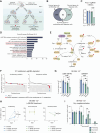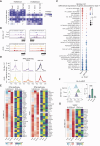H4K20me3-Mediated Repression of Inflammatory Genes Is a Characteristic and Targetable Vulnerability of Persister Cancer Cells
- PMID: 39476057
- PMCID: PMC7617193
- DOI: 10.1158/0008-5472.CAN-24-0529
H4K20me3-Mediated Repression of Inflammatory Genes Is a Characteristic and Targetable Vulnerability of Persister Cancer Cells
Abstract
Anticancer therapies can induce cellular senescence or drug-tolerant persistence, two types of proliferative arrest that differ in their stability. While senescence is highly stable, persister cells efficiently resume proliferation upon therapy termination, resulting in tumor relapse. Here, we used an ATP-competitive mTOR inhibitor to induce and characterize persistence in human cancer cells of various origins. Using this model and previously described models of senescence, we compared the same cancer cell lines under the two types of proliferative arrest. Persister and senescent cancer cells shared an expanded lysosomal compartment and hypersensitivity to BCL-XL inhibition. However, persister cells lacked other features of senescence, such as loss of lamin B1, senescence-associated β-galactosidase activity, upregulation of MHC-I, and an inflammatory and secretory phenotype (senescence-associated secretory phenotype or SASP). A genome-wide CRISPR/Cas9 screening for genes required for the survival of persister cells revealed that they are hypersensitive to the inhibition of one-carbon (1C) metabolism, which was validated by the pharmacologic inhibition of serine hydroxymethyltransferase, a key enzyme that feeds methyl groups from serine into 1C metabolism. Investigation into the relationship between 1C metabolism and the epigenetic regulation of transcription uncovered the presence of the repressive heterochromatic mark H4K20me3 at the promoters of SASP and IFN response genes in persister cells, whereas it was absent in senescent cells. Moreover, persister cells overexpressed the H4K20 methyltransferases KMT5B/C, and their downregulation unleashed inflammatory programs and compromised the survival of persister cells. In summary, this study identifies distinctive features and actionable vulnerabilities of persister cancer cells and provides mechanistic insight into their low inflammatory activity. Significance: Cell persistence and senescence are distinct states of proliferative arrest induced by cancer therapy, with persister cells being characterized by the silencing of inflammatory genes through the heterochromatic mark H4K20me3. See related commentary by Schmitt, p. 7.
©2024 The Authors; Published by the American Association for Cancer Research.
Conflict of interest statement
M. Kovatcheva reports personal fees from mesoestetic and Galapagos outside the submitted work. A.E. Lord reports grants and personal fees from Barry Reed Fund outside the submitted work. M. Serrano reports grants from AECC during the conduct of the study, as well as other support from Altos Labs, Inc, Rejuversen, AG, Senolytic Therapeutics, SL, Life Biosciences, Inc., and grants from Galapagos, NV outside the submitted work. No disclosures were reported by the other authors.
Figures









References
-
- Wang B, Kohli J, Demaria M. Senescent cells in cancer therapy: friends or foes? Trends Cancer 2020;6:838–57. - PubMed
-
- Vallette FM, Olivier C, Lézot F, Oliver L, Cochonneau D, Lalier L, et al. . Dormant, quiescent, tolerant and persister cells: four synonyms for the same target in cancer. Biochem Pharmacol 2019;162:169–76. - PubMed
MeSH terms
Substances
Grants and funding
LinkOut - more resources
Full Text Sources
Molecular Biology Databases
Research Materials
Miscellaneous

